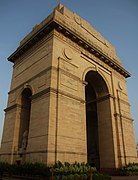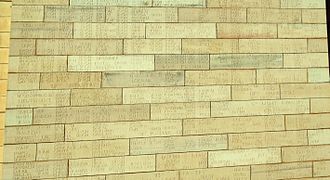The India Gate (originally called the All India War Memorial) is a war memorial located astride the Rajpath, on the eastern edge of the ‘ceremonial axis’ of New Delhi, India, formerly called Kingsway.
India Gate is a memorial to 70,000 soldiers of the Indian Army who died in the period 1914–21 in the First World War, in France, Flanders, Mesopotamia, Persia, East Africa, Gallipoli and elsewhere in the Near and the Far East, and the Third Anglo-Afghan War. 13,300 servicemen's names, including some soldiers and officers from the United Kingdom, are inscribed on the gate.[1][2]The India Gate, even though a war memorial, evokes the architectural style of the triumphal arch like the Arch of Constantine, outside the Colosseum in Rome, and is often compared to the Arc de Triomphe in Paris, and the Gateway of India in Mumbai. It was designed by Sir Edwin Lutyens.[1]
In 1971, following the Bangladesh Liberation war, a small simple structure, consisting of a black marble plinth, with a reversed rifle, capped by a war helmet, bounded by four eternal flames, was built beneath the soaring Memorial Archway. This structure, called Amar Jawan Jyoti, or the Flame of the Immortal Soldier, since 1971 has served as India's Tomb of the Unknown Soldier. India Gate is counted among the largest war memorials in India.
History[edit]
The India Gate situated in Delhi,was part of the work of the Imperial War Graves Commission (I.W.G.C), which came into existence in December 1917 for building war graves and memorials to soldiers killed in the First World War[3]
The foundation stone of the All-India War Memorial was laid on 10 February 1921, at 4:30 PM, by the visiting Duke of Connaught in a solemn soldierly ceremony attended by Officers and Men of the Indian Army, Imperial Service Troops, the Commander in Chief, and Chelmsford, the viceroy.[4] On the occasion, the viceroy said, "The stirring tales of individual heroism, will live for ever in the annals of this country", and that the memorial which was a tribute to the memory of heroes, "known and unknown" would inspire, future generations to endure hardships with similar fortitude and "no less valour".[4]
The King, in his message, read out by the Duke said "On this spot, in the central vista of the Capital of India, there will stand a Memorial Archway, designed to keep" in the thoughts of future generations "the glorious sacrifice of the officers and men of the Indian Army who fought and fell". During the ceremony, the Deccan Horse, 3rd Sappers and Miners, 6th Jat Light Infantry, 34th Sikh Pioneers, 39th Garhwal Rifles, 59th Scinde Rifles (Frontier Force), 117th Mahrattas, and 5th Gurkha Rifles(Frontier Force), were honoured with title of "Royal" in recognition of the distinguished services and gallantry of the Indian Army during the Great War".[4]
Ten years after the foundation stone laying ceremony, on February 12, 1931, the All India War Memorial was inaugurated by Viceroy Lord Irwin, who on the occasion said "those who after us shall look upon this monument may learn in pondering its purpose something of that sacrifice and service which the names upon its walls record."[1]
In the decade between the laying of foundation stone of the War memorial and its inauguration, the rail-line was shifted to run along the Yamuna river, and the New Delhi Railway Station was opened in 1926.[5][6]
The India gate, which is illuminated every evening, from 19:00 to 21:30, is a major tourist attraction. Cars, traveled through India Gate until it was closed to traffic. The Republic DayParade starts from Rashtrapati Bhavan and passes around the India Gate.
Design[edit]
The All-India War Memorial in New Delhi was designed by Edwin Lutyens, who was not only the main architect of New Delhi, but a leading designer of war memorials. He was a member of the IWGC, and one of Europe's foremost designers of war graves and memorials. He designed sixty-six war memorials in Europe, including the highly regarded Cenotaph, in London, in 1919, the first national war memorial erected after World War I, for which he was commissioned by David Lloyd George, the British prime minister.[3] All-India War Memorial in New Delhi, like the Cenotaph, in London, is secular memorial, free of religious and "culturally-specific iconography such as crosses". Lutyens according to his biographer, Christopher Hussey, relied on "elemental Mode", a style of commemoration based on "universal architectural style free of religious ornamentation". The India Gate, which has been called a "creative reworking of the Arc de Triomphe" has a span of 30 feet, and lies on the eastern axial end of Kingsway, present day Rajpath, the central vista and main ceremonial procession route in New Delhi.[3]
The 42-metre tall India Gate, stands on a low base of red Bharatpur stone and rises in stages to a huge moulding. The shallow domed bowl at the top was intended to be filled with burning oil on anniversaries but this is rarely done. The India Gate hexagon complex, with a diameter of about 625 metres, covers approximately 306,000 m² in area.
The best time to visit India Gate is amid summers. Generally people prefer visiting the place after sunset or at night so as to view the illuminated India Gate and enjoying with the flock of locals at this time.
Inscriptions[edit]
The cornice of the India Gate is inscribed with the Imperial suns while both sides of the arch have INDIA, flanked by the dates MCMXIV (1914 left) and MCMXIX (1919 right). Below the word INDIA, in capital letters, is inscribed:
Names on the India Gate[edit]
13,218 war dead are commemorated by name on the India Gate. Due to security reasons access to read the names on the memorial is restricted. The names can be however be seen on the Delhi Memorial (India Gate website, which lists the names with date of death,unit, regiment, place on gate where name is inscribed, location, and other information.) The names on the gate include that of a female staff nurse from the Territorial Force, killed in action in 1917.[7]
Canopy[edit]
About 150 metres East of the India Gate war memorial, at a junction of six roads, is a 73-foot cupola, inspired by a sixth-century pavilion from Mahabalipuram. Lutyens used four Delhi Order columns to support the domed canopy and its chhajja.[8] [9]
The canopy was constructed in 1936 as part of a tribute to the recently deceased Emperor of India King George V, and originally covered a 70-foot-tall (21.34 m) marble statue by Charles Sargeant Jagger of George V in his coronation robes and Imperial State Crown, bearing the British globus cruciger and sceptre. Until it was removed and relocated in 1968, the statue had stood on a pedestal (under the canopy from 1936) bearing the Royal Coat of Arms and the inscription GEORGE V R I ('Rex Imperator', or 'King Emperor') since about 1911.[10]
Even after India's independence in 1947, the statue remained standing at its original location for another two decades, but increasingly became a target of opposition from some Indian politicians, particularly after the tenth anniversary of Independence and the centennial of the Indian Rebellion of 1857. Two days before Independence Day in 1965, members of the Samyukta Socialist Party overpowered two constables guarding the site, covered the statue in tar and defaced its imperial crown, nose and one ear, also leaving a photo of Subhas Chandra Bose at the monument.[10] Subsequently, the Indian government decided to relocate the statue, but faced considerable difficulties in doing so. A proposal to repatriate the towering monument to the UK was rejected by the British government, which cited the lack of an appropriate site and sufficient funds. The British High Commission in New Delhi declined to have the statue relocated to their compound, due to limited space. Efforts to move the statue to a Delhi park were strongly opposed by the nationalist Bharatiya Jana Sangh, which then held power in the city. Finally, in late 1968, the statue was removed from under the canopy and briefly placed in storage before being moved to Coronation Park shortly after, to join other British Raj-era statues.[10]
During and after the statue's removal, it was often suggested that a statue of Mahatma Gandhi be placed under the canopy.[10] The suggestion was even discussed in the Indian Parliament. In 1981, the Government in response to a question in Parliament, confirmed that it was considering the installation of a Gandhi statue under the empty canopy, but nothing came of it.[11]
Amar Jawan Jyoti[edit]
Amar Jawan Jyoti, or the flame of the immortal soldier, is a structure consisting of black marble plinth, with reversed L1A1 Self-loading rifle, capped by war helmet, bound by four urns, each with the permanent light (jyoti) from (CNG) flames,[12] erected under the India Gate in the wake Liberation of Bangladesh in December 1971 to commemorate Indian soldiers killed in the defense of their country. It was inaugurated by the then Prime Minister Indira Gandhi on 26 January 1972, the 23rd Republic Day. Since the installation of the Amar Jawan Jyoti, in 1971, it has served as India's Tomb of the Unknown Soldier. Amar Jawan Jyoti is manned round the clock by soldiers drawn from the three services of the Indian armed forces. Wreaths are placed at the Amar Jawan Jyoti on 26 January, by the Prime Minister of India, and Chiefs of Armed Forces; on Vijay Diwas, and on Infantry Day.[13] Infantry Day, is the day Indian Infantry air landed at Srinagar on 27 October 1947 to stop and defeat the Pakistani mercenaries attack on Jammu and Kashmir. 68th Infantry day was marked by ‘Wreath Laying’ ceremony at ‘Amar Jawan Jyoti’ by Chief of Army Staff, Gen Dalbir Singh, and by Lt Gen Chandra Shekhar (Retd) on behalf of Infantry veterans.[14]
National War Memorial[edit]
In July 2014 the Government announced plans to construct a National War Memorial around the canopy, and a National War Museum in adjoining Princess Park. The War Memorial and Museum are expected to cost Rupees 400 crores or about US Dollars 66 Million.[15]



















No comments:
Post a Comment